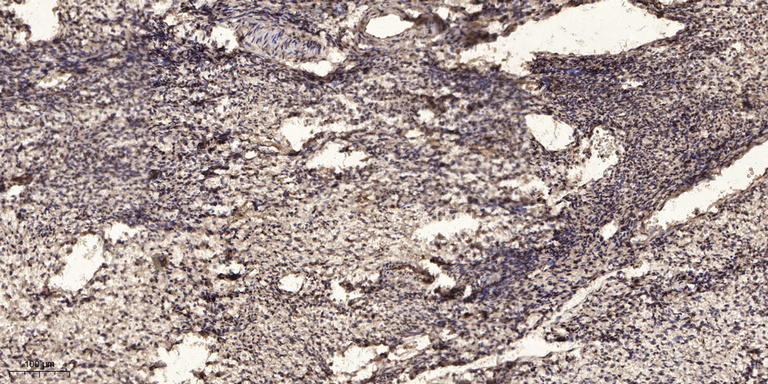I-TAC rabbit pAb
- Catalog No.:YT7846
- Applications:WB;IHC
- Reactivity:Human;Mouse
- Target:
- I-TAC
- Fields:
- >>Cytokine-cytokine receptor interaction;>>Viral protein interaction with cytokine and cytokine receptor;>>Chemokine signaling pathway;>>Toll-like receptor signaling pathway
- Gene Name:
- CXCL11 ITAC SCYB11 SCYB9B
- Protein Name:
- I-TAC
- Human Gene Id:
- 6373
- Human Swiss Prot No:
- O14625
- Mouse Gene Id:
- 56066
- Mouse Swiss Prot No:
- Q9JHH5
- Immunogen:
- Synthesized peptide derived from human I-TAC AA range: 45-94
- Specificity:
- This antibody detects endogenous levels of Human I-TAC
- Formulation:
- Liquid in PBS containing 50% glycerol, 0.5% BSA and 0.02% sodium azide.
- Source:
- Polyclonal, Rabbit,IgG
- Dilution:
- WB 1:500-2000;IHC 1:50-300
- Purification:
- The antibody was affinity-purified from rabbit antiserum by affinity-chromatography using epitope-specific immunogen.
- Concentration:
- 1 mg/ml
- Storage Stability:
- -15°C to -25°C/1 year(Do not lower than -25°C)
- Other Name:
- C-X-C motif chemokine 11 (Beta-R1;H174;Interferon gamma-inducible protein 9;IP-9;Interferon-inducible T-cell alpha chemoattractant;I-TAC;Small-inducible cytokine B11)
- Molecular Weight(Da):
- 10kD
- Background:
- disease:Expressed in a variety of skin disorders, including allergic contact dermatitis, lichen planus and mycosis fungoides.,function:Chemotactic for interleukin-activated T-cells but not unstimulated T-cells, neutrophils or monocytes. Induces calcium release in activated T-cells. Binds to CXCR3. May play an important role in CNS diseases which involve T-cell recruitment. May play a role in skin immune responses.,induction:By interferon gamma and interferon beta. Induction by IFN-gamma is enhanced by TNF-alpha in monocytes, dermal fibroblasts and endothelial cells, and by IL-1 in astrocytes.,mass spectrometry: PubMed:10233762,online information:CXCL11 entry,similarity:Belongs to the intercrine alpha (chemokine CxC) family.,tissue specificity:High levels in peripheral blood leukocytes, pancreas and liver astrocytes. Moderate levels in thymus, spleen and lung. Low levels in placenta, prostate and small intestine. Also found in epidermal basal layer keratinocytes in skin disorders.,
- Function:
- chemotaxis, defense response, inflammatory response, immune response, cell surface receptor linked signal transduction, G-protein coupled receptor protein signaling pathway, cell-cell signaling, behavior, locomotory behavior,response to wounding, taxis,
- Subcellular Location:
- Secreted.
- Expression:
- High levels in peripheral blood leukocytes, pancreas and liver astrocytes. Moderate levels in thymus, spleen and lung. Low levels in placenta, prostate and small intestine. Also found in epidermal basal layer keratinocytes in skin disorders.
- June 19-2018
- WESTERN IMMUNOBLOTTING PROTOCOL
- June 19-2018
- IMMUNOHISTOCHEMISTRY-PARAFFIN PROTOCOL
- June 19-2018
- IMMUNOFLUORESCENCE PROTOCOL
- September 08-2020
- FLOW-CYTOMEYRT-PROTOCOL
- May 20-2022
- Cell-Based ELISA│解您多样本WB检测之困扰
- July 13-2018
- CELL-BASED-ELISA-PROTOCOL-FOR-ACETYL-PROTEIN
- July 13-2018
- CELL-BASED-ELISA-PROTOCOL-FOR-PHOSPHO-PROTEIN
- July 13-2018
- Antibody-FAQs
- Products Images

- Immunohistochemical analysis of paraffin-embedded human oophoroma. 1, Antibody was diluted at 1:200(4° overnight). 2, Tris-EDTA,pH9.0 was used for antigen retrieval. 3,Secondary antibody was diluted at 1:200(room temperature, 45min).


